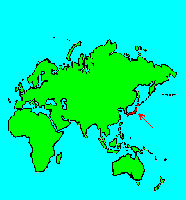SPECIES INFO
Stewartia serrata is native to southern Japan. This shrub or small tree has somewhat rounded leaves. The leaves, per its species name, are toothed. The jagged petals are off-white and marked with red.Stewartia genus is native to eastern North America and also the Orient (mostly Japan.) There are nine species in this genus. These are mostly shrubs or small trees with reddish bark. The typically single axillary flowers are large and showy. There are five, rarely six, sepals and petals. Two species, malacodendron and ovata, are established in the greater North America. This genus has been spelled as Stuartia in the past.
Tea Family (Theaceae) is a family of about 500 species of trees and bushes arranged into about 28 different genera. This is a tropical family that is found in the south eastern United States, and from Mexico south to most of central and northern South America. This family is also found in tropical Africa, and also in tropical Asia from India to China and south through SE Asia to Indonesia. Camellia sinensis is the plant that provides most tea leaves. There are 12 species arranged in seven genera established in greater North America.
Parietales Order is a large assemblage containing over thirty different families. The violets are a well-known group in this order. The St. Johnswort family is another well known family in this order. Passion flowers also belong here.
Some authors argue this order should be divided, and others have divided it into several orders.
Dicots (Dicotyledoneae Class) are the predominant group of vascular plants on earth. With the exception of the grasses (Monocots) and the Conifers (Gymnosperms), most of the larger plants that one encounters are Dicots. Dicots are characterized by having a seed with two outer shell coverings.
Some of the more primitive Dicots are the typical hardwood trees (oaks, birches, hickories, etc). The more advanced Dicots include many of the Composite (Aster) Family flowers like the Dandelion, Aster, Thistles, and Sunflowers. Although many Monocots reach a very high degree of specialization, most botanists feel that the Dicots represent the most advanced group of plants.
Seed plants (Phylum Embryophyta) are generally grouped into one large phylum containing three major classes: the Gymnosperms, the Monocots, and the Dicots. (Some scientists separate the Gymnosperms into a separate phylum and refer to the remaining plants as flowering plants or Angiospermae.)
For North American counts of the number of species in each genus and family, the primary reference has been John T. Kartesz, author of A Synonymized Checklist of the Vascular Flora of the United States, Canada, and Greenland (1994). The geographical scope of his lists include, as part of greater North America, Hawaii, Alaska, Greenland, Puerto Rico, and the Virgin Islands.
Kartesz lists 21,757 species of vascular plants comprising the ferns, gymnosperms and flowering plants as being found in greater North America (including Alaska, Hawaii, Greenland, Puerto Rico and the Virgin Islands.
There are estimates within the scientific world that about half of the listed North American seed plants were originally native with the balance being comprised of Eurasian and tropical plants that have become established.
Plant kingdom contains a large variety of different organisms including mosses, ferns, and seed plants. Most plants manufacture their energy from sunlight and water. Identification of many species is difficult in that most individual plants have characteristics that have variables based on soil moisture, soil chemistry, and sunlight.
Because of the difficulty in learning and identifying different plant groups, specialists have emerged that study only a limited group of plants. These specialists revise the taxonomy and give us detailed descriptions and ranges of the various species. Their results are published in technical journals and written with highly specialized words that apply to a specific group.
On the other hand, there are the nature publishers. These people and companies undertake the challenging task of trying to provide easy to use pictures and descriptions to identify those species.



